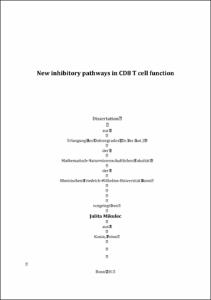Mikulec, Julita: New inhibitory pathways in CD8 T cell function. - Bonn, 2016. - Dissertation, Rheinische Friedrich-Wilhelms-Universität Bonn.
Online-Ausgabe in bonndoc: https://nbn-resolving.org/urn:nbn:de:hbz:5n-43827
Online-Ausgabe in bonndoc: https://nbn-resolving.org/urn:nbn:de:hbz:5n-43827
@phdthesis{handle:20.500.11811/6772,
urn: https://nbn-resolving.org/urn:nbn:de:hbz:5n-43827,
author = {{Julita Mikulec}},
title = {New inhibitory pathways in CD8 T cell function},
school = {Rheinische Friedrich-Wilhelms-Universität Bonn},
year = 2016,
month = jun,
note = {An adaptive immune response is initiated upon recognition of antigen presented on the surface of antigen-presenting cell (APC) by T cells. CD8 T cells primed in the liver by antigen-presenting liver sinusoidal endothelial cells (LSECs) develop into nonresponsive cells with a memory-phenotype. Liver-primed CD8 T cells are not terminally committed to this unique differentiation state but develop into effector cells upon infection. The adaptive immune response is balanced by co-stimulatory and co-inhibitory signals. LSEC-primed CD8 T cells require co-inhibitory PD-L1 signals delivered by LSECs to develop into a nonresponsive/memory state. In this study we investigated the relation between PD-L1/PD-1 signaling at early time-points and formation of an immune synapse, which may play a role in further development of effector function in T cells.
Upon antigen-specific interaction of APC and T cell, an immunological synapse is formed at their interface that is required for signaling exchanged between these cells. In this study, we demonstrate that LSEC-CD8 T cell interaction results in multifocal immune synapse formation. Furthermore, although the development of nonresponsive state of liver-primed CD8 T cells requires co-inhibitory PD-L1/PD-1 signaling, the formation and phenotype of the immune synapse did not. Not only the absence of PD-L1 signaling, but also delivery of CD28 co-stimulatory signals can prevent differentiation of CD8 T cells into nonresponsiveness after priming by LSEC. Interestingly, we found that co-stimulation via CD28 was able to overcome this unique differentiation program when introduced between 0 and 36 hours of LSEC-CD8 T cell coculture, indicating that co-inhibitory PD-1 signaling is required to be integrated during this time to induce typical liver-primed non-responsive memory like T cells.
Gene expression analysis identified the small GTPase ADP-ribosylation factor 4D (Arl4d) to be overexpressed in LSEC-primed CD8 T cells, compared to DC-primed CD8 T cells. More interestingly, Arl4d expression in CD8 T cells during LSEC-priming is dependent on PD-L1/PD-1 signaling. Similar to T cells activated in the presence of co-inhibitory PD-1 signaling, in the presence of Arl4d expression IL-2 production by CD8 T cells is attenuated in vitro and in vivo. In addition, Arl4d restricts effector CD8 T cell development and expansion on viral infection. Taken together, this study reveals a new as-yet undiscovered inhibitory function of Arl4d in modulating T cell immunity most likely via the regulation of IL-2 availability. Therefore, Arl4d might act downstream of co-inhibitory PD-1 signaling and thus play role in the regulation of CD8 T cell immunity.},
url = {https://hdl.handle.net/20.500.11811/6772}
}
urn: https://nbn-resolving.org/urn:nbn:de:hbz:5n-43827,
author = {{Julita Mikulec}},
title = {New inhibitory pathways in CD8 T cell function},
school = {Rheinische Friedrich-Wilhelms-Universität Bonn},
year = 2016,
month = jun,
note = {An adaptive immune response is initiated upon recognition of antigen presented on the surface of antigen-presenting cell (APC) by T cells. CD8 T cells primed in the liver by antigen-presenting liver sinusoidal endothelial cells (LSECs) develop into nonresponsive cells with a memory-phenotype. Liver-primed CD8 T cells are not terminally committed to this unique differentiation state but develop into effector cells upon infection. The adaptive immune response is balanced by co-stimulatory and co-inhibitory signals. LSEC-primed CD8 T cells require co-inhibitory PD-L1 signals delivered by LSECs to develop into a nonresponsive/memory state. In this study we investigated the relation between PD-L1/PD-1 signaling at early time-points and formation of an immune synapse, which may play a role in further development of effector function in T cells.
Upon antigen-specific interaction of APC and T cell, an immunological synapse is formed at their interface that is required for signaling exchanged between these cells. In this study, we demonstrate that LSEC-CD8 T cell interaction results in multifocal immune synapse formation. Furthermore, although the development of nonresponsive state of liver-primed CD8 T cells requires co-inhibitory PD-L1/PD-1 signaling, the formation and phenotype of the immune synapse did not. Not only the absence of PD-L1 signaling, but also delivery of CD28 co-stimulatory signals can prevent differentiation of CD8 T cells into nonresponsiveness after priming by LSEC. Interestingly, we found that co-stimulation via CD28 was able to overcome this unique differentiation program when introduced between 0 and 36 hours of LSEC-CD8 T cell coculture, indicating that co-inhibitory PD-1 signaling is required to be integrated during this time to induce typical liver-primed non-responsive memory like T cells.
Gene expression analysis identified the small GTPase ADP-ribosylation factor 4D (Arl4d) to be overexpressed in LSEC-primed CD8 T cells, compared to DC-primed CD8 T cells. More interestingly, Arl4d expression in CD8 T cells during LSEC-priming is dependent on PD-L1/PD-1 signaling. Similar to T cells activated in the presence of co-inhibitory PD-1 signaling, in the presence of Arl4d expression IL-2 production by CD8 T cells is attenuated in vitro and in vivo. In addition, Arl4d restricts effector CD8 T cell development and expansion on viral infection. Taken together, this study reveals a new as-yet undiscovered inhibitory function of Arl4d in modulating T cell immunity most likely via the regulation of IL-2 availability. Therefore, Arl4d might act downstream of co-inhibitory PD-1 signaling and thus play role in the regulation of CD8 T cell immunity.},
url = {https://hdl.handle.net/20.500.11811/6772}
}






